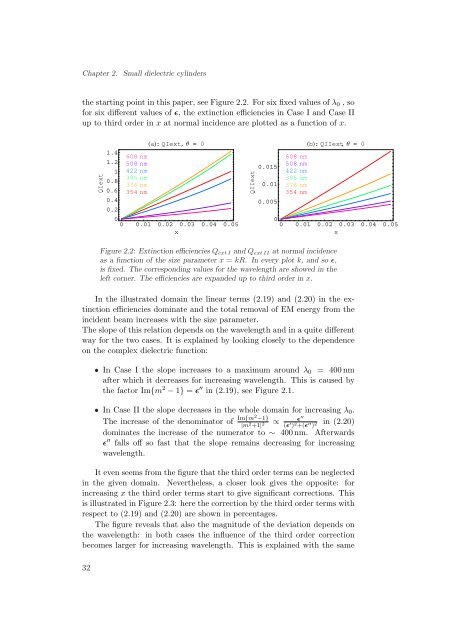Optical properties of cylindrical nanowires
Optical properties of cylindrical nanowires
Optical properties of cylindrical nanowires
You also want an ePaper? Increase the reach of your titles
YUMPU automatically turns print PDFs into web optimized ePapers that Google loves.
Chapter 2.Small dielectric cylindersthe starting point in this paper, see Figure 2.2. For six fixed values <strong>of</strong> λ 0 , s<strong>of</strong>or six different values <strong>of</strong> ɛ, the extinction efficiencies in Case I and Case IIup to third order in x at normal incidence are plotted as a function <strong>of</strong> x.QIext1.41.210.80.60.4608 nm508 nm422 nm395 nm376 nm354 nma:QIext,Θ ⩵ 00.200 0.01 0.02 0.03 0.04 0.05xQIIext0.0150.010.005608 nm508 nm422 nm395 nm376 nm354 nmb:QIIext,Θ ⩵ 000 0.01 0.02 0.03 0.04 0.05xFigure 2.2: Extinction efficiencies Q ext I and Q ext II at normal incidenceas a function <strong>of</strong> the size parameter x = kR. In every plot k, and so ɛ,is fixed. The corresponding values for the wavelength are showed in theleft corner. The efficiencies are expanded up to third order in x.In the illustrated domain the linear terms (2.19) and (2.20) in the extinctionefficiencies dominate and the total removal <strong>of</strong> EM energy from theincident beam increases with the size parameter.The slope <strong>of</strong> this relation depends on the wavelength and in a quite differentway for the two cases. It is explained by looking closely to the dependenceon the complex dielectric function:• In Case I the slope increases to a maximum around λ 0 = 400 nmafter which it decreases for increasing wavelength. This is caused bythe factor Im{m 2 − 1} = ɛ ′′ in (2.19), see Figure 2.1.• In Case II the slope decreases in the whole domain for increasing λ 0 .The increase <strong>of</strong> the denominator <strong>of</strong> Im{m2 −1} ɛ∝ ′′in (2.20)|m 2 +1| 2 (ɛ ′ ) 2 +(ɛ ′′ ) 2dominates the increase <strong>of</strong> the numerator to ∼ 400 nm. Afterwardsɛ ′′ falls <strong>of</strong>f so fast that the slope remains decreasing for increasingwavelength.It even seems from the figure that the third order terms can be neglectedin the given domain. Nevertheless, a closer look gives the opposite: forincreasing x the third order terms start to give significant corrections. Thisis illustrated in Figure 2.3: here the correction by the third order terms withrespect to (2.19) and (2.20) are shown in percentages.The figure reveals that also the magnitude <strong>of</strong> the deviation depends onthe wavelength: in both cases the influence <strong>of</strong> the third order correctionbecomes larger for increasing wavelength. This is explained with the same32
















